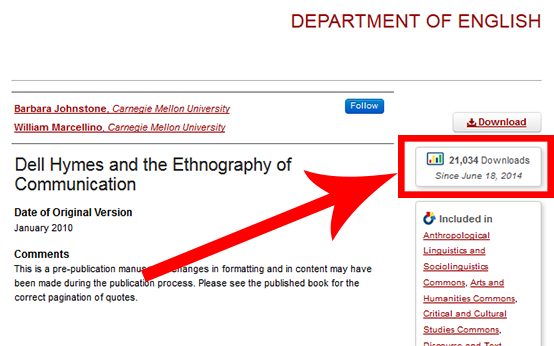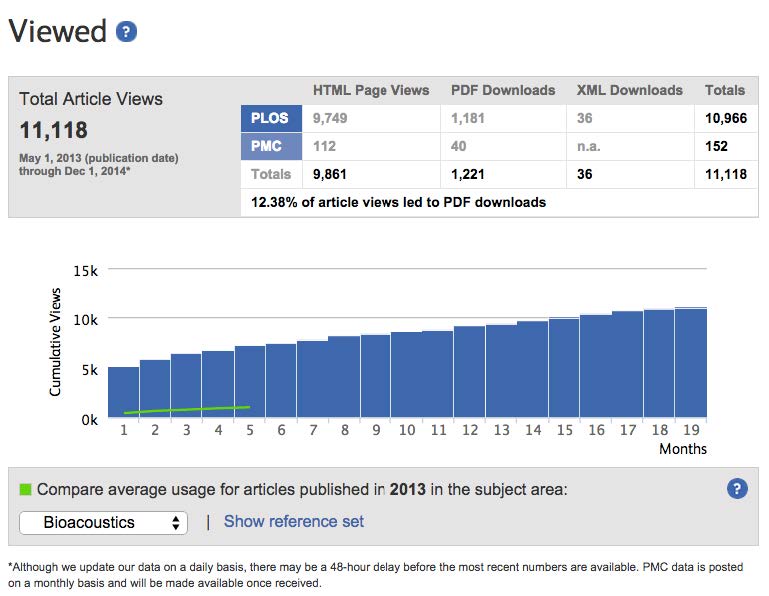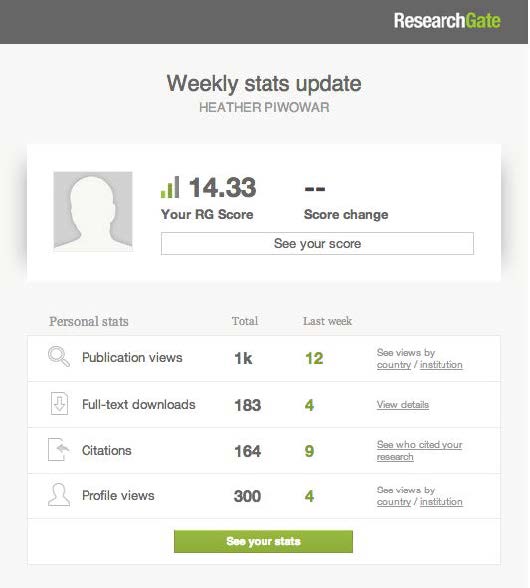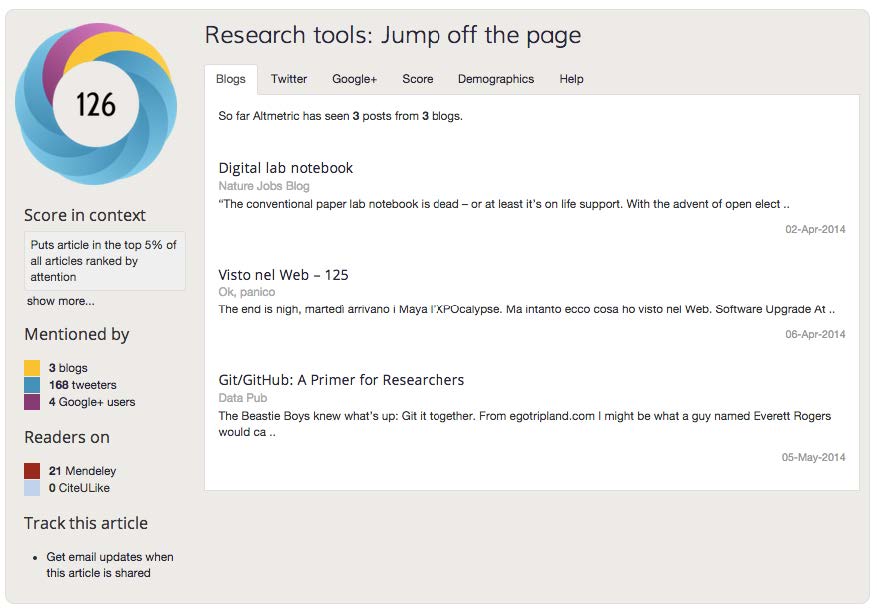Discover when your work is discussed & shared online
Okay, so you’re engaging other scholars online and making your work
more discoverable, but how can you tell if it's helping? Well, let's
talk about that--keeping tabs on your research’s many impacts, that is!
In today’s challenge, we’ll explore how the services you’ve signed up
for–Academia.edu, Google Scholar, and so on–and others can be used to
track the impacts of all of your research outputs. However, if you
really want an in-depth look at where and how your scholarship is making
the rounds, we do suggest meeting with a librarian. Contact Lisa Sciulli at 412.396.5346 to schedule an appointment. You might also want to review our guide on discovering and understanding your scholarly impact.
412.396.5346 to schedule an appointment. You might also want to review our guide on discovering and understanding your scholarly impact.
Let’s dig in!
more discoverable, but how can you tell if it's helping? Well, let's
talk about that--keeping tabs on your research’s many impacts, that is!
In today’s challenge, we’ll explore how the services you’ve signed up
for–Academia.edu, Google Scholar, and so on–and others can be used to
track the impacts of all of your research outputs. However, if you
really want an in-depth look at where and how your scholarship is making
the rounds, we do suggest meeting with a librarian. Contact Lisa Sciulli at
Let’s dig in!
Step 1: Set up citation alerts
Citations are the “coin of the realm” to track scholarly impact, notonly for your articles but also your research data, too. You can get
citation alerts in three main ways: from Google Scholar, from
traditional citation indices, and from certain databases.
Google Scholar Citation Alerts
Your Google Scholar profilecan be used to alert you whenever your articles receive new citations
online. It tracks any citations to your publications that occur on the
scholarly web.
If you haven’t already signed up for citation alerts...
- Log on to scholar.google.com (click "Sign in" in the top right corner of the page.)
- Click "My Citations" at the top of the page. this should bring you to your Google Scholar profile.
- Click the blue “Follow” button at the top of your profile.
- Check the box for “Follow new citations” and make sure the email address displayed is your preferred one.
- Click “Create alert.” Notifications will arrive in your inbox when you receive new citations.
page, and click on the number of citations to the right of the article
you want to track citations for:

On the next page, you’ll see a list of all the papers that have cited
you, some of which you’ll be able to click-through and read:

Remember: Google Scholar indexes citations it finds in a wide range
of scholarly documents (white papers, slide decks, and of course journal
articles are all fair game) and in documents of any language. The data
pool is also mixed with respect to peer-review status; some of these
citations will be in the peer-reviewed literature, some will not. This
means that your citation count on Google Scholar may be larger than on
other citation services.
Scopus Alerts
In Scopus, you can set up alerts for both articles and authors. To create an alert for an article,- Search for the article and then and click on the title in your search results.
- Once you’re on the Article Abstract screen, you will see a list of
papers that cite your article on the right-hand side. To set your alert,
click “Set citation alert” under “Inform me when this document is cited
in Scopus.”

- Click the Author Search tab on the Scopus homepage and run a search
for your name. If multiple results are returned, check the author
affiliation and subjects listed to find your correct author profile.

- Next, click on your author profile link.
- On your author details page, follow the “Get citation alerts” link.

- At this point, if you have not yet created a Scopus account, you will need to create one.
- Click the "Not Registered?" link.
- Enter your information and click the "Register" button.
- You should see a message saying your registration was successful and a "Continue" button. Click the button.
- You should now be back on your author details page and you can proceed by clicking the “Get citation alerts” link again.
- Create a name for your saved alert, set an email address at which
you would like to receive the alerts, and select your preferred
frequency of alerts.
- Once you’re finished, click "Set Alert."
With alerts set for these two services, you’ll now be notified when
your work is cited in many, many publications worldwide! But citations
only capture a very specific form of scholarly impact. How do we learn
about other uses of your articles?
Step 2: Page views & downloads
How many people are reading your work? While you can’t be certainthat article page views and full-text downloads mean people are reading
your articles, many scientists still find these measures to be a good
proxy. And some repositories like Dryad and Figshare provide this
information, too, so you can track the interest in the datasets, slides,
and other content you upload.
Duquesne University Digital Commons
The Duquesne University Digital Commons institutional repository,which will probably launch sometime in the next six months, offers a
new, very powerful platform for preserving and increasing the
discoverability of your scholarly and creative output. We'll talk more
about the repository in general tomorrow; for now, we'll just focus on
mining readership data through usage statistics provided by the
repository software.
As an example, let's take a look at Carnegie Mellon University's
institutional repository (built with the same software we acquired):
On each item's page, you can view the number of downloads for that work:

(view this page live)
Maybe not as helpful, but definitely neat, you can also view a map of
live readership--that is, where content repository-wide is being
downloaded in real time. View the live map here.

More notably, once you've published your work in the repository,
you'll receive monthly e-mail reports of what you have uploaded and how
many times your work has been downloaded in the previous month. You will
also be able to access an Author Dashboard, which provides similar,
real-time analytics like where your work is being downloaded (at which
institutions and geographical locations), when it was downloaded, and,
of course, how many times it has been downloaded. Read more about this on bepress' website.


Although the repository has not yet launched, keep your eyes and ears
open for the call for content so you can get in on the ground floor.
Publisher websites
Publishers like PLOS display pageview and download information for individual articles on their website,
alongside other data like citations and altmetrics.
Let’s take a closer look at PLOS’s page view & download metrics.
PLOS combines page views that happen on their website with page views
and downloads the article receives on PubMed Central in a single view on the top of the article’s page:

If you click on the metrics tab of the article page, you get more
useful information: total views and download numbers by source, over
time; a basic impact graph; and a graph of the relative popularity of
this article, compared to articles in the same discipline that are
published in PLOS:

Here’s a closer look at the views and downloads grid and graph:

On articles’ Metrics pages, PLOS also provides other data, including
citations from a variety of sources, social media and scholarly
bookmarking services.
For PLOS and many other publishers, these metrics are only available
on their websites. Some pioneering publishers go one step further,
sending you an email when you’ve got new page views and downloads on
their site.
Publisher notifications
In addition to displaying page views and downloads on their websites, publishers like PeerJ and Frontiers send notification emails as a service to their authors. Not a PeerJ orFrontiers author? Contact your publisher to find out if they offer
notifications for metrics related to articles you’ve published.
If you are a PeerJ or Frontiers author, here are some pointers:
If you’re a PeerJ author, you should receive notification
emails by default once your article is published. But if you want to
check if your notifications are enabled, sign into PeerJ.com, and click
your name in the upper right hand corner. Select “Settings.” Choose
“Notification Settings” on the left navigation bar, and then select the
“Summary” tab. You can then choose to receive daily or weekly summary
emails for articles you’re following.
In Frontiers journals, it works like this: once logged in, click the
arrow next to your name on the upper left-hand side and select
“Settings.” On the left-hand nav bar, choose “Messages,” and under the
“Other emails” section, check the box next to “Frontiers monthly impact
digest.”
Both publishers aggregate activity for all of the publications you’ve
published with them, so no need to worry about multiple emails crowding
your inbox at once.
ResearchGate & Academia.edu

Both ResearchGate and Academia.edu will report how many people have viewed and downloaded your paper on their site.
You can turn on email notifications for page views and downloads by doing the following...
- Log in to ResearchGate or Academia.edu.
- On either site, click/hover over you profile picture in the upper
right-hand corner of your screen and click "Settings"/"Account
Settings." - Then, click on the “Notifications”/Email Notifications in the
sidebar menu (on the right for ResearchGate, on the left for
Academia.edu). - Check off the types of emails you want to receive. (Note: on
ResearchGate, you should click each of the headings next to the right
arrow to view your options.)
notifications is described as “There’s new activity in my analytics
(includes “Analytics Snapshot”)”; Academia.edu provides data for:
On ResearchGate, the option to receive page view & download
Profile views indicate the amount of times your profile has been viewed.
Paper views indicate the amount of times all of your papers have been viewed.
Unique visitors is how many
individual people have visited your papers OR your profile. This differs
from profile or paper views because one unique visitor could visit
multiple papers or view your profile more than once.
notifications is under Stats > “When someone reads my work.”
ResearchGate defines "reads" as:
A read is counted when somebody:
Reads the full-text or summary of any type of research (e.g., journal article, conference paper, dataset) on ResearchGate
Downloads a file hosted on ResearchGate, including direct downloads from Google Scholar and other search engines
Step 3: Altmetrics with Altmetric.com
What are other researchers saying about your articles around thewater cooler? It used to be that we couldn’t track these informal
conversations, but now we’re able to listen in using social media sites
like Twitter and on blogs. Here’s how.
First off, for those who may be unfamiliar, "altmetrics," or
"alternative metrics," refers to newer measures of impact that look at
article-level data like pageviews, number of downloads, news coverage,
and social shares. Many different altmetrics systems exist, including PLoS' Article Level Metrics (ALM), Plum Analytics, and Altmetric score (not to be confused with the lower-case generic term, altmetrics). Let's look at capital "A" Altmetric.
Altmetric allows you to track "altmetrics" and receive notifications
for any article that you have published that’s got a DOI, PubMed ID,
ArXiv ID, or Handle.
- First, install the Altmetric.com browser bookmarklet (visit this page and drag the “Altmetric It!” button into your browser menu bar).

- Then, find your article on the publisher’s website and click the
“Altmetric it!” button. The altmetrics for your article will appear in
the upper right-hand side of your browser window, in a pop-up box
similar to the one below.

Note: the article must have a DOI, PubMed ID, ArXiv ID, or Handle
in order for the bookmarklet to work. If the article does have one of
these, but you're still having trouble, try refreshing the page,
highlighting the DOI/PubMed ID/etc. and then clicking the bookmarklet. - Next, follow the “Click for more details” link in the Altmetric
pop-up. You’ll be taken to a detailed report of your metrics and the
underlying qualitative data.
lets you read the individual blogs, policy documents, newspapers, and
other online outlets that mention your article. The donut visualization
at the top-left of the report includes a single, weighted score that
attempts to sum up the attention that your work has received. Below the
visualization is contextual information that shows you how the article’s
metrics compare to those of articles published in the same year,
journal, and so on.

At the bottom left-hand corner of the page, you can sign up to
receive notifications whenever someone mentions your article online.
The only drawback of Altmetric.com’s notification emails is that you
have to sign up for a new notification for each article. This can cause
inbox mayhem if you are tracking many publications.
That's
it! You're done for the day. Next up: open access publishing to
increase the impacts of your work AND/OR open peer review.
Back to topit! You're done for the day. Next up: open access publishing to
increase the impacts of your work AND/OR open peer review.
License
Adapted under a CC-BY 4.0 license from the The 30-Day Impact Challenge: The Ultimate Guide to Raising the Profile of Your Research eBook published by Impactstory.org and authored by Stacy Konkiel.


No comments:
Post a Comment